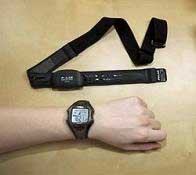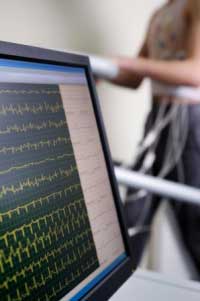Discuss this article on the forums
(Thanks to Jennifer Spotila and the CFIDS Association for allowing us to post  this inquiry into a complicated issue in ME/CFS – ‘exercise’ You can find the original copy of the article here.)
this inquiry into a complicated issue in ME/CFS – ‘exercise’ You can find the original copy of the article here.)
Exercise is a four-letter word to many people with chronic fatigue syndrome (CFS). Every patient has been told by a doctor, family member and/or friend that exercise would help him/her feel better. Every patient has tried to be physically active in some way and experienced the same end result: relapse and post-exertional malaise (PEM) that makes them feel much worse, not better. There is a chasm between what many doctors recommend and what patients experience. Why? Is there any way for patients to engage in physical activity without PEM?
Graded exercise therapy (GET) has been recommended as a treatment for CFS for many years. In conventional GET, the patient is instructed to increase activity according to a schedule, regardless of symptom status. Numerous GET studies have claimed improvement in fatigue and other symptoms in the studied CFS patients.1 However, a careful examination of those studies raises questions about cohort selection, drop-out rates, and study design.2 There is evidence, both in patient surveys and in research literature, that many CFS patients experience symptom exacerbation and serious setbacks after GET.3 Research has also suggested that there may be activity ceilings for CFS patients, such that activity cannot be increased past a certain limit.4 Despite the conflicting research, some doctors may take the GET studies at face value and recommend exercise to CFS patients on that basis.
 Doctors may insist that exercise is necessary because it is a successful treatment or adjutant therapy for people with a wide variety of conditions and illnesses. Dr. Todd Davenport notes, “The usual prescription for fatigue is exercise. Patients reporting fatigue come to a physical therapist, they are supported in exercising, and they feel better. But CFS breaks many of the rules health care providers are taught about how the body works in response to exercise.” CFS patients are trapped in an alternate universe where exercise is not just difficult, but actually makes them sicker. There is abundant evidence of physical abnormalities in CFS patients after exercise, giving rise to symptom exacerbation beyond normal aches and pains.5
Doctors may insist that exercise is necessary because it is a successful treatment or adjutant therapy for people with a wide variety of conditions and illnesses. Dr. Todd Davenport notes, “The usual prescription for fatigue is exercise. Patients reporting fatigue come to a physical therapist, they are supported in exercising, and they feel better. But CFS breaks many of the rules health care providers are taught about how the body works in response to exercise.” CFS patients are trapped in an alternate universe where exercise is not just difficult, but actually makes them sicker. There is abundant evidence of physical abnormalities in CFS patients after exercise, giving rise to symptom exacerbation beyond normal aches and pains.5
Health care providers must understand the unique effects of exercise on people with CFS. Just as CFS patients may be overly sensitive to medications, even in reduced doses, they are sensitive to exercise, which causes a delayed relapse even if the exercise seems well tolerated at the time. Therefore, “Like pharmaceutical therapies, prescribing exercise as therapy . . . must be predicated on understanding the risks and benefits of exercise as thoroughly as possible. Only in this manner can the ‘right’ dose be achieved.”6
Is there a way for CFS patients to be physically active at some level without triggering a relapse? Some researchers believe that – for at least some patients – the answer is yes. “It is possible to adapt exercise advice compassionately and intelligently to the individual situation.”7 Several methods of determining safe levels of exercise have been proposed, including methods from Drs. Clapp,8 Davenport,9 Nijs,10 and Wallman.11 The conceptual model proposed by Davenport and his colleagues from the Fatigue Lab at the University of the Pacific uses an objective measure – the patient’s heart rate – to help patients be physically active without causing PEM, and that is the model discussed here.
Dual Energy Systems
In order to understand this conceptual model, one must first understand the body’s energy systems. Dr. Christopher Snell likens the human body to a hybrid car. A hybrid car has an electric motor (the anaerobic energy system), and a gas engine (the aerobic energy system) powered by gasoline (oxygen). The car’s electric motor operates until it is out of energy, and then the gas motor takes over to provide energy and recharge the electric motor. But Snell says that in CFS, “The gas engine doesn’t work efficiently and can’t recharge the electric motor. The patient quickly exhausts the energy available in the electric motor, and then must wait a long time for that energy to be replenished.”
 Anaerobic energy is depleted after two minutes of activity, while the aerobic system is simultaneously ramping up to take over energy production. The point at which the body can no longer generate enough energy using oxygen is called the Anaerobic Threshold (AT). Every person then requires rest in order to repay the oxygen debt they have incurred.
Anaerobic energy is depleted after two minutes of activity, while the aerobic system is simultaneously ramping up to take over energy production. The point at which the body can no longer generate enough energy using oxygen is called the Anaerobic Threshold (AT). Every person then requires rest in order to repay the oxygen debt they have incurred.
Exercise physiologist Staci Stevens offers a three-part example. An athlete can climb two flights of stairs without fatigue or shortness of breath. A sedentary overweight person might climb the same two flights of stairs and feel out of breath, but will recover completely after a brief rest. A person with CFS may struggle to climb the stairs, and experience severe fatigue and PEM. In other words, the CFS patient reaches the AT after much less exertion than a healthy person, and requires a longer period of time to recover.
The exact mechanisms for why this happens in CFS patients are not known, but Dr. Snell points out that this lower AT is likely the result of malfunctions in the patients’ aerobic energy system. Patients can work around this problem in two ways. First, patients can keep their heart rates under the level that corresponds to their ATs to avoid taxing the dysfunctional aerobic system. Second, patients can take advantage of the anaerobic energy system by limiting exercise to two-minute intervals, alternated with rest. These strategies can condition the anaerobic energy system to improve its function, while also minimizing reliance on the aerobic energy system. Snell, Stevens and Davenport use exercise testing to calculate an individual’s AT, but patients can estimate their own AT with a simple calculation12 or with some careful experimentation.
Start Low and Go Slow
Patients can begin with detailed observation of heart rate and activity. Stevens recommends wearing a heart rate monitor and noting one’s heart rate frequently throughout the day. Every activity can affect the heart rate, including lying down, sitting up, watching television, cooking a meal, climbing stairs, showering, etc. Patients should also pay attention to how different activities feel. Stevens suggests using the Borg scale13 to measure an individual’s Rating of Perceived Exertion (RPE). Using this scale, an individual assigns a number between 6 and 20 to the overall level of perceived exertion during an activity. By observing heart rate and RPE, patients can begin to establish correlations and identify AT limits. For example, cooking a meal could raise a patient’s heart rate to 110 beats per minute and feel very hard (17 on the scale). For such a patient, that heart rate (110 bpm) might be over his/her AT.
 The Pacific Fatigue Lab model uses heart rate biofeedback to help CFS patients stay within a safe zone: activity must be under the AT and must be followed by sufficient rest. The patient’s heart rate monitor is set with an alarm for 10 percent below the AT. When a patient’s heart rate reaches that number, the monitor alarm sounds and the patient should immediately sit down and rest. The alarm is an objective measure of how hard the CFS body is working, and helps patients recognize when they are exceeding their limitations.
The Pacific Fatigue Lab model uses heart rate biofeedback to help CFS patients stay within a safe zone: activity must be under the AT and must be followed by sufficient rest. The patient’s heart rate monitor is set with an alarm for 10 percent below the AT. When a patient’s heart rate reaches that number, the monitor alarm sounds and the patient should immediately sit down and rest. The alarm is an objective measure of how hard the CFS body is working, and helps patients recognize when they are exceeding their limitations.
How might this translate into safe exercise? First, Stevens says that patients need to abandon the definition of “exercise” they had when healthy. Now, every activity should be treated as exertion and must stay within the safe zone under the AT. With that in mind, “Exercise interventions for people with CFS/ME must be carefully customized to reflect the unique needs of each individual.”14 Stretching and range of motion exercises can be implemented first, but the patient’s heart rate must remain below the target AT. Once these activities are well tolerated, a patient may experiment with short-duration (less than 2 minutes), low intensity interval training. Again, the heart rate must stay below the target AT, and each interval must be followed by adequate rest. Any activity that causes an increase in symptoms lasting more than a few hours is too rigorous, and should be reduced or eliminated.
Patients all along the continuum of illness severity may be able to benefit from this method. A bed bound patient may need assistance to turn in bed or complete basic activities such as showering, but heart rate biofeedback can help identify the appropriate pace and duration of these activities. Bed bound patients can also try deep diaphragmatic breathing, perhaps six deep breaths at a time. Deep breathing will lower heart rate, and also work the large muscles of the diaphragm. Severely ill patients might begin with passive stretching, where a physical therapist or caregiver moves the patient’s limbs slowly and carefully to gently stretch muscles and try to improve flexibility. Care must also be taken to avoid aggravating any symptoms of orthostatic intolerance, a condition common in people with CFS.15
Caution is essential when experimenting with any increase in activity. Stevens emphasizes that “the body is right,” and that when an activity feels too hard then the individual should stop and rest, no matter what the heart rate monitor says. Patients should not exceed RPE of 13 to 15, corresponding to the exertion feeling “somewhat hard.” Remember that a person with CFS cannot replenish energy using oxygen in the same way as a healthy person. Pain might equal gain for healthy people, but this is not the case for CFS. Slow but steady is the best way for a CFS patient, where every activity is done at the pace and duration likely to prevent symptom exacerbation.
 According to the Pacific Fatigue Lab model, it is critical for CFS patients to avoid taxing their aerobic energy systems, and to incorporate sufficient rest periods into any activity. The model’s combination of methods (heart rate monitoring, RPE scale, short-duration activity) accompanied by sufficient rest can help ensure “that physical activity is maintained at an appropriate level to facilitate optimal pacing self-management.”16 This may help attenuate the push-crash cycle that traps many CFS patients, or as Dr. Davenport says, “to steady the rate of activity by cutting off the peaks in order to fill in the valleys.” Experimentation with activities, pacing, rest periods, and symptom monitoring is an essential part of finding safe activity limits in each individual situation. Health care providers “should use caution during the creation and progression of [any physical] training program because the safety and effectiveness of these interventions in people with CFS/ME require additional research.”17
According to the Pacific Fatigue Lab model, it is critical for CFS patients to avoid taxing their aerobic energy systems, and to incorporate sufficient rest periods into any activity. The model’s combination of methods (heart rate monitoring, RPE scale, short-duration activity) accompanied by sufficient rest can help ensure “that physical activity is maintained at an appropriate level to facilitate optimal pacing self-management.”16 This may help attenuate the push-crash cycle that traps many CFS patients, or as Dr. Davenport says, “to steady the rate of activity by cutting off the peaks in order to fill in the valleys.” Experimentation with activities, pacing, rest periods, and symptom monitoring is an essential part of finding safe activity limits in each individual situation. Health care providers “should use caution during the creation and progression of [any physical] training program because the safety and effectiveness of these interventions in people with CFS/ME require additional research.”17
CFS patients and their health care providers share the same goals: reduced symptoms, improved functionality, minimized deconditioning, and better health. Patients and providers must find new ways to work towards these goals cooperatively. Physical activity is essential to human health, but CFS is unique in how it affects the body’s response to exercise. People with CFS cannot simply exercise and feel better. Exercise – of the wrong type or in the wrong amount – will exacerbate CFS. Therefore, physical activity must be attempted carefully and cautiously, using some method to help patients identify and stay within their limits.
It may be challenging for people with CFS to allocate energy to such activity if they have difficulty keeping up with routine tasks of daily life, and this decision is highly individual. Health care providers need a compassionate understanding of CFS and the effects of activity. People with CFS need patience and a willingness to experiment. A new delicate balance must be found so that both sides can cooperate in supporting people with CFS to be as active as is safely possible.
Writer Jennifer Spotila, J.D., is a member of the CFIDS Association’s Board of Directors.
______________________________
1See Table 2, Davenport, T, Stevens, S, VanNess, M, et al. (2010) Conceptual Model for Physical Therapist Management of Chronic Fatigue Syndrome/Myalgic Encephalomyelitis. Physical Therapy, 90 (4): 602-614.
2Twisk, F & Maes, M. (2009) A review on cognitive behavioral therapy (CBT) and graded exercise therapy (GET) in myalgic encephamyelitis (ME)/chronic fatigue syndrome (CFS): CBT/GET is not only ineffective and not evidence-based, but also potentially harmful for many patients with ME/CFS. Neuroendocrinology Letters, 30(3): 284-299.
3Kindlon, T & Goudsmit, E. (2010) Graded Exercise for Chronic Fatigue Syndrome: Too Soon to Dismiss Reports of Adverse Reactions. Journal of Rehabilitative Medicine, 42: 184-186.
4Black, C & McCully, K (2005) Time course of exercise induced alterations in daily activity in chronic fatigue syndrome. Dynamic Medicine, 4: 10
5See the CFIDS Association’s four-part series on post-exertional malaise: https://www.cfids.org/cfidslink/2010/pem-series.asp
6Cooper, D, Radom-Aizik, S, et al. (2007) Dangerous exercise: lessons learned from dysregulated inflammatory responses to physical activity. Journal of Applied Physiology, 103: 700-709.
7Bateman L. CFS and the exercise conundrum, https://www.iacfsme.org/CFSandExercise/tabid/103/Default.aspx accessed September 12, 2010.
8Clapp, L, Richardson, M, et al. (1999) Acute effects of thirty minutes of light-intensity, intermittent exercise on patients with Chronic Fatigue Syndrome. Physical Therapy, 79 (8): 749-756.
9Davenport (2010).
10Nijs, J, Paul, L & Wallman, K. (2008) Chronic Fatigue Syndrome: An Approach Combining Self-management with Graded Exercise to Avoid Exacerbations. Journal of Rehabilitative Medicine, 40: 241-247.
11Wallman, K, Morton, A, et al. (2005) Exercise prescription for individuals with chronic fatigue syndrome. Medical Journal of Australia, 183(3): 142-143.
12Age-predicted maximum heart rate = 220 minus person’s age. For example, 220-40=180. The estimated AT for this individual 50% of age-predicted heart rate, or 90 beats per minute.
13Centers for Disease Control, Perceived Exertion, https://www.cdc.gov/physicalactivity/everyone/measuring/exertion.html accessed August 18, 2010.
14Davenport (2010).
15Rowe, P. Managing Orthostatic Intolerance, Webinar for The CFIDS Association, September 1, 2010, https://www.youtube.com/watch?v=5iF30TVLaRE accessed September 22, 2010.
16Davenport (2010).
17Davenport (2010).
The CFIDS Association of America assumes no liability for any medical treatment or other activity undertaken by readers. For medical advice, please consult your personal health care professional
